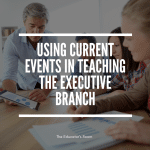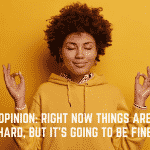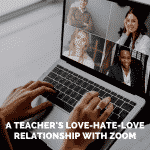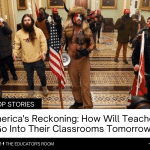Kim Lee is a physics teacher at Pinole Valley High School in West Contra Costa Unified School District. She has been teaching for the last four years. She is the teacher sponsor of the Anti-Racism Club and helps run the Peer Tutoring Program. She is committed to promoting diversity and equity through STEM education, as well as creating an inclusive school climate and classroom.

I had played trumpet for the school band since the fifth grade, but I started my freshman year of high school enrolled in Art as my elective. I tried to stick it out, but by the third week of school, I made the decision to go to my counselor and plead for him to change my schedule. I told him that playing trumpet was my one true passion; I really missed playing it and wanted to be switched into band class. He granted my wish, and soon I was back in the brass section playing the third trumpet with a bunch of baseball players in the Concert Band, where I would stay for the rest of high school.
This may seem like a small scheduling success story on the surface, but in reality, there is a lot more to it. The truth is that I had initially signed up for Art. I never felt confident in playing music and was eager to leave my days as a middle school trumpet player behind. The first day went well – I liked the teacher and was excited to have so many art supplies at my disposal. On the second day, I worked on the assignment when a paper airplane landed next to me. I picked it up to see the words “China Express” written on it. I turned around to a group of boys laughing at me – I recognized the loudest of them, Michael, a boy in my older brother’s grade who was about twice my size. I stuffed the airplane in my backpack and cried myself to sleep that night.
The incidents kept coming – there was the note they left on my desk that said “Go back to China” and then the time they hid my backpack in a cabinet. Finally, one day Michael whispered “Chink” at me as he and his friends walked past me into the room. I still remember what their chuckles sounded like. I knew I had to get out of the class, so that afternoon, I walked into my counselor’s office and told him about my wholly made-up musical aspirations. Walking into the Band room the next day felt like walking into a safe haven.
Fast forward twelve years, and I am back in high school–but this time as a teacher. With the rise of anti-Asian hate crimes, the Atlanta spa shootings in March, and the resulting media gaslighting (the words “not a hate crime” still hitting a painful spot for me now 8 months later), several Asian students (including some I never had) have come to me to share their fears and experiences. However, it is disheartening to hear that they still hear the same jokes and remarks as I did when I was a student over a decade later.
Thinking back, what strikes me the most about my own experience is the decisions I made as a 13-year-old to get out of my situation. My Art teacher and my counselor were friendly, well-meaning people. But even though my Art teacher had given me no reason to not trust her, I never once told her what was happening or asked her for help. And even though my counselor never gave me any cause to believe he wouldn’t listen to me, I lied to him with no hesitation.
Instinctively, I made those decisions to avoid any risk of being kept in a class with Michael. To avoid any risk that others would find out and I would be judged. To avoid the risk that, even as they helped me, I would have to hear my teacher or counselor minimize or equate the situation to childish behavior when I knew it to be something much darker – this, in particular, is a risk I have only learned how to put into words in recent years.
The reality is that in my first few weeks of high school, I cried myself to sleep most nights because I did not feel safe in my learning environment. We, as teachers and humans, know that safety is one of the most basic needs for a child.
Twelve Years Forward
This experience makes me wonder – what kinds of things am I missing in my own classroom with my own students who don’t look like me? For example, last year, three in four African American students at my school reported having experienced explicit racism on campus. Still, only one in four Black or African American students said they would report an incident to any adult in the room. Likewise, three in four students of any race reported having witnessed xenophobic comments or behavior on campus. Still, the number of complaints (or lack of complaints) that other colleagues and I have heard doesn’t match that.
To fight hate of any form on K-12 campuses, we first need to realize that the problem– racial bullying and the use of racist “jokes”– is one of safety and thus should be a top priority. We also must realize that the scope of the problem is more extensive and more profound, and often more harmful than we see or hear. So what can we do about it?
We can all be more vocal against any and all forms of hate in the classroom. This means more than just inclusive signs on the wall or generic statements. In addition to encouraging inclusiveness and respect for all regardless of background, race/ethnicity, and culture in our rooms, we need to vocally acknowledge the reality that the opposite does exist. It also means acknowledging and giving space for the current events in the country and world that may be troubling for some of us to hear about but are deeply personal and painful for parts of our student body.
I think of my own experience, as that is all that I can speak to – maybe I would have asked my teacher for help if I knew (because she let it be known) that she would do everything in her power to listen and protect students from the hate we see in the world.
I think of how three in four African American students at the school I teach at said that they would be more likely to report a racist incident to a teacher of any race if that teacher was periodically vocal against discrimination in the classroom.
There is more than one way to be vocal. Districts must provide teachers with the tools to create more culturally affirming learning environments to be vocally antiracist in what they teach and how they teach. The devices have changed as the world has changed, and teachers K through 12 should be trained on actual trauma-informed practices. Teachers should be provided time, resources, education, and continued support in creating or adopting a curriculum that promotes healthy conversation about race and identity from a young age. There is nothing wrong with acknowledging this is new to many of us while also acknowledging it’s time, and it’s been the time for many years, that we get to work on this.
At the same time, while being more vocal allies to our diverse students is something we can all begin doing, we should also recognize that it is no replacement for actual representation. I, as an Asian woman, could never be all the unspoken roles a Black male teacher could be in a Black male student’s eyes, no matter how vocal I am against the anti-Blackness I witness in our school. I could never replace the power of having a teacher role model who went through their own immigration journey and experience navigating a new country in the eyes of an immigrant student. So that all of our students can be afforded the basic need of safety and a sense of security and thus belonging in the classroom. We must all advocate for policies that encourage a more diverse teacher workforce. This means more than just hiring teachers of color for the sake of diversity – this means intentionally recruiting and streamlining pathways into the profession while also planning programs for retention that directly address the needs expressed by teachers themselves.
From both my experiences as a student and teacher, I know that a more inclusive classroom and school culture benefits everybody. We can do some of these things mentioned above while consciously maintaining an antiracist lens and purpose, and sinking into the discomfort that sometimes comes with that, we can help address the urgent need of making our schools safer spaces for students of all races.






